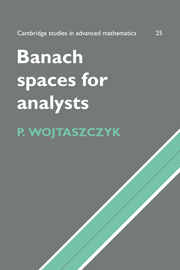Preface
Published online by Cambridge University Press: 03 May 2010
Summary
Banach space theory became a recognised part of the mathematical scene with the appearance of Banach [1932]. From its birth it maintained close ties with the rest of analysis. It turned out that Banach space theory offered powerful tools to other branches of analysis. The most useful ones are duality theory for spaces and operators, results about infinite dimensional convexity and results connected with the Baire category theorem, most notably the closed graph theorem. These powerful general concepts are now well known among analysts and appear in almost every textbook on functional analysis or real variable theory. They were already well understood in the forties and fifties, and at that time it seemed to many that Banach space theory was dead or at least relegated to an obscure corner of science. However, this was not the case. The sixties, and especially the seventies and eighties, saw an enormous eruption of activity in the field. Old problems were solved and, more importantly, new problems and new ties with the rest of mathematics emerged. Also, new and powerful methods and directions of research appeared.
For those in the field progress seemed to be constantly accelerating, but to those outside it may have looked as if the theory was dying again. Probably one of the reasons for this perception was that this research activity (maybe because it was so dynamic) unfortunately did not produce many books on the subject, and those that did appear were usually devoted to a special topic. There are two notable exceptions to this statement, Beauzamy [1982] and Lindenstrauss-Tzafriri [1977, 1979].
- Type
- Chapter
- Information
- Banach Spaces for Analysts , pp. ix - xivPublisher: Cambridge University PressPrint publication year: 1991



